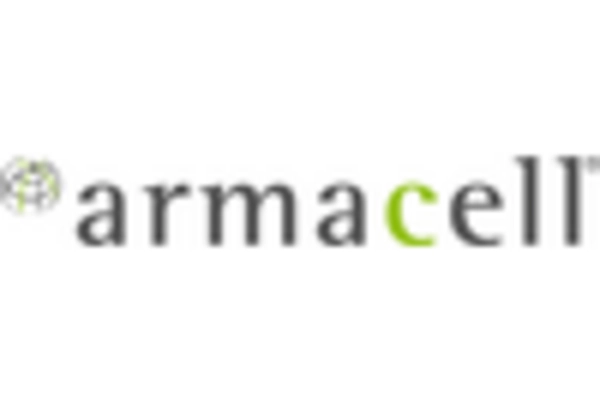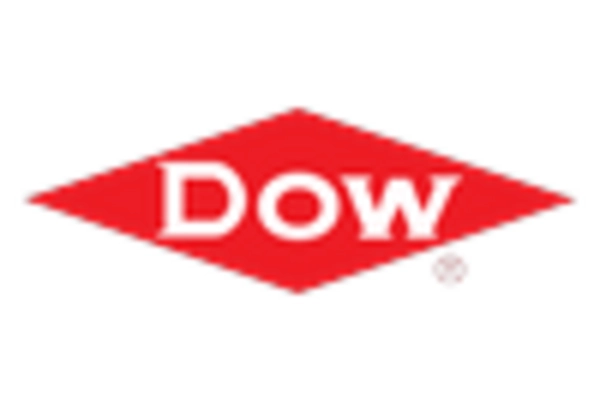Rising Demand in Automotive Sector
The automotive sector is experiencing a notable increase in the demand for flexible elastomeric foam, primarily due to its lightweight and energy-absorbing properties. This material is increasingly utilized in vehicle interiors, including seats, headliners, and sound insulation. The flexible elastomeric foam market is projected to witness a growth rate of approximately 5% annually, driven by the automotive industry's shift towards lightweight materials to enhance fuel efficiency. Additionally, the growing emphasis on passenger comfort and safety is likely to further propel the adoption of flexible elastomeric foam in automotive applications. As manufacturers seek to comply with stringent regulations regarding emissions and safety, the integration of flexible elastomeric foam appears to be a strategic choice, potentially leading to a more sustainable automotive future.
Expansion of Consumer Electronics Market
The consumer electronics market is experiencing rapid growth, which is positively impacting the flexible elastomeric foam market. This material is widely used in electronic devices for cushioning and protection, particularly in smartphones, tablets, and wearable technology. The flexible elastomeric foam market is projected to grow at a rate of 7% annually, driven by the increasing demand for lightweight and durable materials in consumer electronics. As manufacturers strive to enhance product performance and user experience, the integration of flexible elastomeric foam is becoming more prevalent. Additionally, the trend towards compact and portable devices necessitates the use of materials that provide both protection and flexibility. This suggests a promising outlook for flexible elastomeric foam in the consumer electronics sector.
Increased Focus on Health and Safety Standards
The heightened awareness of health and safety standards across various industries is driving the demand for flexible elastomeric foam. This material is often utilized in applications requiring cushioning and shock absorption, such as in medical devices and personal protective equipment. The flexible elastomeric foam market is witnessing a surge in demand as manufacturers strive to enhance product safety and comfort. Recent statistics indicate that the healthcare sector is projected to grow by 6% annually, with flexible elastomeric foam being integral to the development of safer medical products. Additionally, the ongoing emphasis on workplace safety is likely to further boost the adoption of flexible elastomeric foam in industrial applications, where it serves to protect workers from injuries. This trend suggests a robust future for flexible elastomeric foam in health and safety applications.
Growth in Construction and Building Applications
The construction and building sector is increasingly recognizing the advantages of flexible elastomeric foam, particularly in insulation and soundproofing applications. This material offers excellent thermal insulation properties, which are essential for energy-efficient building designs. The flexible elastomeric foam market is anticipated to expand as more construction projects prioritize sustainability and energy efficiency. According to recent data, the construction sector is expected to grow at a rate of 4% annually, with flexible elastomeric foam playing a crucial role in meeting energy performance standards. Furthermore, the versatility of this foam allows for its use in various applications, including HVAC systems and roofing, thereby enhancing its market appeal. As the demand for eco-friendly building materials rises, flexible elastomeric foam is likely to become a preferred choice among architects and builders.
Technological Innovations in Manufacturing Processes
Technological advancements in manufacturing processes are significantly influencing the flexible elastomeric foam market. Innovations such as improved molding techniques and automated production lines are enhancing the efficiency and quality of foam production. These advancements are likely to reduce production costs and lead to higher output, thereby making flexible elastomeric foam more accessible to various industries. The market is expected to grow at a rate of 5% annually, driven by these technological improvements. Furthermore, the introduction of new formulations and additives is enabling manufacturers to create customized foam solutions tailored to specific applications. As industries increasingly seek specialized products, the role of technology in the flexible elastomeric foam market appears to be pivotal in meeting diverse customer needs.

















Leave a Comment